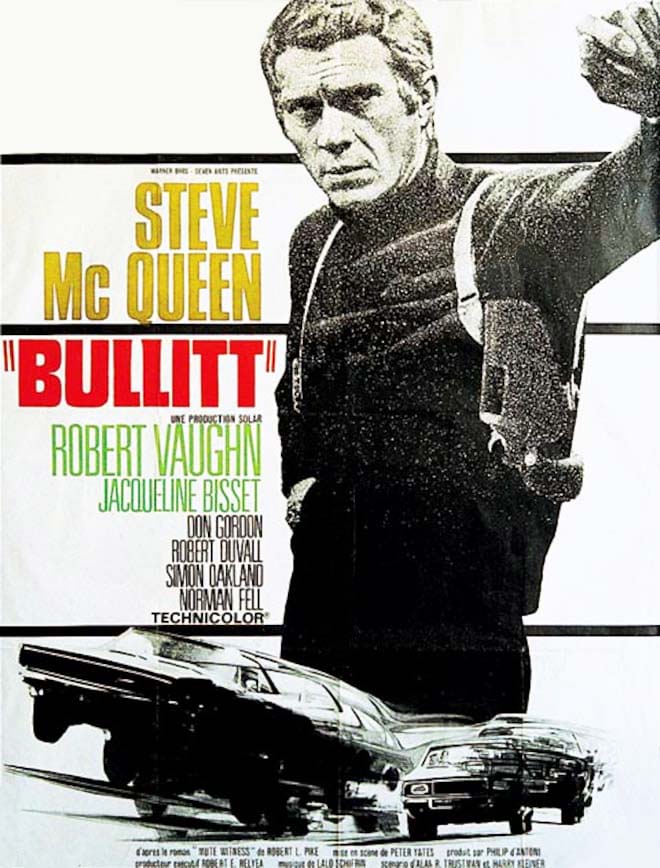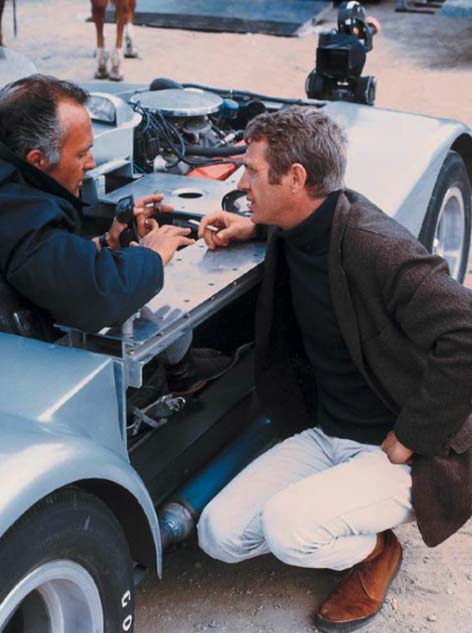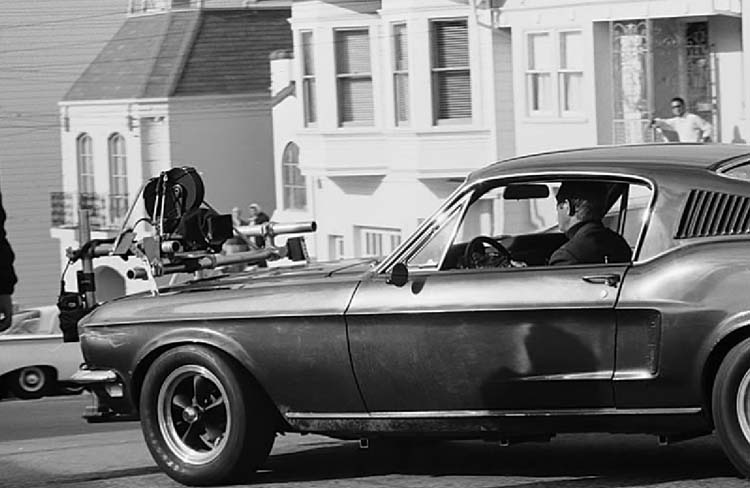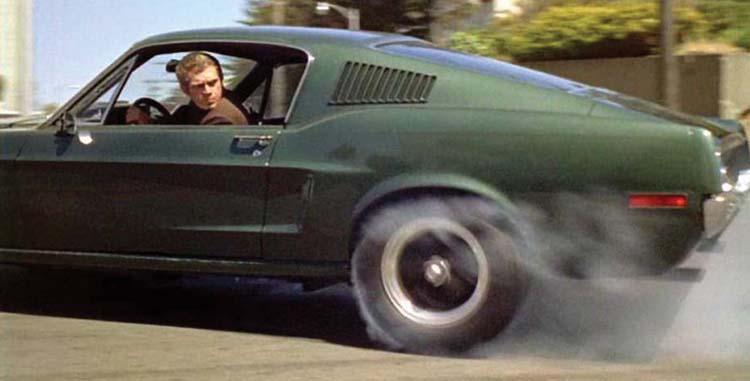'Bullitt': Cars, Locations, People and The Era

Recently, Jack Baruth at The Truth About Cars favorably reviewed the classic 1968 movie, 'Bullitt' - the one with the spectacular CGI-free, 10-minute car chase, done at actual speeds, in a closed-off 60-block section of San Francisco. The Highland Green 1968 Ford Mustang GT Fastback with American Racing mag wheels instantly became an automotive icon. As did its nemesis: the black 1968 Dodge Charger.
In addition to the awesome chase sequence, I enjoyed the movie on its own merits. The scenes were period-realistic, the characters were believable, and the acting was excellent. The casting seemed perfect. Robert Vaughn was well suited to play the oily and ambitious district attorney, Walter Chalmers. His two unnamed and uncredited butt-boy assistants looked like they were former fraternity members at Faber College's snooty Omega Theta Pi fraternity. They could have been roomies with Greg Marmalard.
Jaqueline Bisset made the perfect architect girlfriend for Lieutenant Frank Bullitt. Although Vic Tayback's part is small, he was a more believable mob boss than as diner owner in TV's 'Alice'. Norman Fell, best known as the hapless Mr. Roper on 'Three's Company', played the consummate prick, Captain Baker, while Simon Oakland was cast as Bullitt's gruff boss, Captain Sam Bennett.
Steve McQueen had quite a bit of input on the film since he owned Solar Productions, co-producer of the movie. McQueen insisted on authenticity regarding the car chase. But conventional camera cars couldn't handle the 100 mph highway sequences. Veteran car builder/racer Max Balchowsky, of old Yeller fame (a series of yellow-painted, homebuilt race cars constructed mostly from junkyard parts powered by Buick nail-head V8s with ugly sheet metal including old metal signs that embarrassed many expensive European sports cars on the track), made a fast-enough camera car using a Corvette chassis:

Accurate car soundtracks were produced by recording the Mustang and Charger going through their paces Willow Springs Raceway near Los Angeles. The opening credits were a series of complex dissolves of names and scenes - something unique and expensive in the pre-digital era of filmmaking.
When Bullitt met girlfriend Cathy and friends at the Coffee Cantata, a cafe on San Francisco's Union Street, there was a jazz quartet performing. The group, Meridian West, was chosen by McQueen when he heard them play at a gig in Sausalito.
Baruth wrote, "There are several long shots of various Pan Am Boeing 707 aircraft; this amounts to fanservice in an era where many moviegoers had yet to experience a trip on a jet airplane or even see one close-up. (Incidentally, the 707 featured most prominently in the film is a 1965-built example evocatively named Jet Clipper Glory of the Skies by Pan Am.) The same holds true for McQueen's decision to shoot the movie mostly on location. The average American could not afford to visit San Francisco on a whim, so 'Bullitt' was both action movie and travelogue. It should be noted that the success of early James Bond films was similarly driven at least in part by the fact that they showed exotic locales in full Technicolor."
Jack's right - 'Bullitt' is also a bit of a travelogue. San Francisco is shown realistically but the seediest parts of the city are left unseen. We see the iconic Mark Hopkins hotel - home of its legendary Top of the Mark lounge and restaurant (on my first trip to SF, my dad requested that I have a drink there - I obliged because he had fond memories of the place from his WWII Navy days) - with its small but elegant drop-off area (in the film, there is a silver Aston-Martin coupe and a contemporary Cadillac 75 limousine parked there), numerous shots of cable cars in operation (including one with an ad on its side for Suntory whisky - a brand not sold on the East Coast in those days), the still-in-operation Swiss Louis, a venerable Italian and seafood restaurant on Broadway (I dined there once; the place has been in operation since 1936), Enrico's Sidewalk Cafe, a jazzy haunt of poets, politicians, people-watchers and, occasionally, tourists, along with glimpses of other landmarks within the city.
Probably the most shabby setting in the film is the Daniels Hotel, the safe house where Bullitt is guarding Johnny Ross. Across from Pier 18 and next door to the Salvation Army, it offered weekly room rates of $7-12, according to the sign on the side of the structure. Ross' room had something I'd never seen before - pay radio. You had to drop a quarter in the slot to hear music for an hour. In 50 years, we've apparently come full circle; Sirus XM is 21st Century pay radio.
I suspect that McQueen used his connection within the car community to secure some of the automotive eye candy sprinkled throughout the film. In the opening sequence in the 'Chicago' garage (shot in a San Francisco parking structure on Sutter Street) as Ross makes his escape, a 1968 Bizzarrini 5300 GT spyder/targa, a Corvette-powered Italian sports car, can be seen. What are the chances that this rare car was parked there by happenstance?
Frank Bullitt first meets District Attorney Walter Chalmers at a reception at Claimers' residence, a palatial stone structure in Pacific Heights with a view of the Golden Gate Bridge. Built in 1915 and still in use today, the mansion has 16 rooms including 7 bedrooms. The reception is a ladies tea and all the well-dressed and coiffed women are wearing furs. Outside, pricey vehicles are parked everywhere, including several dark-colored Cadillacs, a green Jaguar Mark X sedan and an imposing and rare black Rolls-Royce Phantom V. Incidentally, McQueen twisted friend Robert Vaughn's arm to get him to play the role of Chalmers.
Throughout the movie, cool, special cars are mixed with 'ordinary' everyday cars which 50 years later have become special, too. Jaqueline Bisset drives a yellow Porsche 356 cabriolet. Pulling up to his apartment, McQueen's character deftly parks the Mustang in front of a cream Austin-Healey. Across the street is a 1938 blue Packard Eight sedan. A flashy, white-and-red, 1968 Cadillac ambulance picks up Ross' body at the hospital. The hospital scenes are gritty and realistic - actual doctors and nurses appeared as extras - and educate younger people about the primitive state of medical equipment in 1968.
Elsewhere in the film a red Porsche 356 Speedster is parked curbside, and a dirty 1967 Corvette roadster with hardtop cruises past the car wash. While most of the cars seen on various streets were American iron, there were quite a few Volkswagen Beetles, including the infamous 1968 shiny green sedan which Bullitt's Mustang passed four times during the chase sequence. As the hitman stopped at a corner in the Dodge Charger, looking for Bullitt, there was a green Ford Falcon parked at the curb. When the Charger's driver turned his head again, the Falcon had magically been replaced by a white-over-red Hillman Minx.

Among the parked cars seen during the chase were a Morris Minor convertible, a white Austin-Healey, a blue MG Midget Mark II, a '41 Plymouth coupe and a couple of nice '55-56 Cadillacs. Sliding a corner, the Charger sideswipes the rear quarter of a parked '56 Ford, taking out a film camera in the process. Bullitt's Mustang can be seen steering clear of the freshly-dented white Ford. Later, during the high-speed part of the chase, the Mustang passes a dark green, top-up Austin-Healey. During the chase sequence, the Dodge Charger lost many hubcaps; some have pegged the number at eleven. Not everything was authentic.

During the entire chase sequence, not a word was spoken by the actors - instead, awesome muscle car noises, the sound of seat belts clicking, gunfire and Lalo Schifrin's nerve-tingling chase music filled the soundtrack. Lalo wrote the movie's original jazz-inspired score, arranged for brass and percussion. For those of a certain age, Mr. Schifrin composed the Music of Your Life: the themes from television shows such as 'Mannix', 'The Man From U.N.C.L.E.', 'Mission Impossible' and 'Starsky and Hutch' as well as movie compositions: 'Cool Hand Luke', 'Dirty Harry', 'Magnum Force', 'Sudden Impact', 'The Exorcist', 'Jaws', 'Kelly's Heros', 'Airport '79' and 'The Sting II'.
The cars, the buildings, and the way people dressed are now a time capsule of the late 1960s era. Contrary to popular belief, America was neither filled with hairy hippies, scantily-clad long-haired female free spirits, nor men dressed like Sgt. Pepper wannabes with Yellow Submarine muttonchop sideburns and wide ties. In '68, most guys had modest sideburns - at most, sort-of like 1955 Elvis. And ties were still narrow.
If you look at the airport scenes and observe the people, most were well-groomed. Folks dressed-up to fly in those days, because plane travel was a special occasion. No shoes, no shirt, no service. The woman at the National Car Rental counter wore a green uniform, not unlike a flight attendant. Bolted to the National counter is an internally-illuminated sign proclaiming "We give S&H Green Stamps." Those under 50 will probably have no idea what that means. In 1968, people were free to move about the airport; there were almost no security lines, although carry-on luggage was hand-inspected at some airports. Families and friends often accompanied passengers right up to the gate and then wave as the plane took off.
As to the airplanes, it was quite unusual to fly in a large 707 jet in '68. I took my first flight that year and began flying on a regular basis for my employer. For shorter flights, prop planes were still common. I remember flying into Evansville, Indiana from Chicago in a four-engine Douglas DC-6. As we began our approach, one of the engines died. My traveling companion, J. Franklin Moore - a veteran traveler, quipped, "Don't worry, we've still got three more." Waiting for a connection in Cleveland, I saw a two-engine DC-3 catch fire as it backed away from the gate. Men with extinguishers quickly put out the engine fire. The pilot restarted the still-smoking engine and taxied to the takeoff point. Such was air travel in the 1960s.
Since my early travels were to places within 1,500 miles of home, I often flew in tri-engined 727 jets or Boeing 737s. The 737 was initially the 'hot rod' of passenger jets - a little plane with huge powerful jet engines hung under the wings. This plane was designed to be usable on very short runways. When taking off, it accelerated quickly and would push you back in your seat.
I frequently traveled to assist with on-site customer injection molding problems which had baffled our field engineers. On those occasions, I carried a leather briefcase containing a pyrometer, a three-quarter-inch diameter brass rod which had been sharpened to a point on one end, a stopwatch and an aerosol can of mold lubricant.
During the Take-Me-To-Cuba hijacker era, I opened my case at Cleveland airport's security desk. The uniformed guard didn't bat an eyelash. She simply asked me, "Which plastic company do you work for and where's the molding problem this time?" Airport security agents were smart and knowledgeable in those days, unlike today's clueless TSA dolts.
Boeing 707s were mostly used for lengthy coast-to-cost flights. In 1977, we took our children (6 and 9 year-olds, respectively) to Washington, DC to see the historic sights and museums.
|
|
|
At Philadelphia International Airport - April, 1977
|
|
We flew out of Philadelphia in a 707 which was deadheading to Dulles where it would fill up and fly to Los Angeles. Since the large airplane was almost empty, my son and daughter were doted on by the flight attendants and deplaned in DC with winged lapel pins, decks of cards and other souvenirs. We wanted to wow our kids with a trip in a big airplane - over 40 years later, they still remember it. (To give them a different travel experience, we returned home on the speedy Amtrak Metroliner, departing from Washington's Union Station.)
Speaking of travel, I should point out that the motel south of San Francisco - where Renick's wife is found murdered - has the typical look and feel of American lodgings of the era. The motor inn seen in 'Bullitt' was the Thunderbolt Motel in Millbrae, just south of San Francisco airport. You'd find motor lodges just like it throughout the U.S. in those days, especially within a five-mile radius of a major airport terminal. Business travelers often arrived late and didn't want the hassle of driving an unfamiliar rental car long distances at day's end. Most of these motels had restaurants; the one in the movie promoted special dinners on Mother's Day on its outdoor signboard - a way to make money from locals during a slow business travel weekend.
Near the end of the movie, after repeatedly trying to get Lieutenant Bullitt fired, Chalmers is driven from the airport in his black 1968 Lincoln Continental sedan with a 'Support Your Local Police' sticker on the rear bumper. Walter Chalmers is last seen in the Lincoln's back seat, reading The Wall Street Journal.
Finally, I'll mention that I got quite a kick out of the small scene at Jaqueline Bisset's architectural office, when she had McQueen looking up water flow data in a reference book, as she was spec'ing out a fountain design. As seniors in Mechanical Engineering, everyone in my college class received a copy of the thick blue Babcock & Wilcox boiler book, complete with tables for easy reference when designing pressure vessel systems. That's how engineering was done in those pre-computer days. Somewhere, I still have the B&W book as well as a red-covered book of steam tables (used for thermodynamic calculations). Incidentally, the scene was filmed at the Telegraph Hill office of architect Lawrence Halprin, designer of outdoor spaces across the nation including the F.D.R. Memorial and Ghirardelli Square.
In 2007, 'Bullitt' was selected for preservation in the United States National Film Registry by the Library of Congress, as "culturally, historically, or aesthetically significant." I wholeheartedly concur with that selection. (posted 2/13/18)
Other Pages Of Interest
| blog: 'The View Through The Windshield' |
| greatest hits: index of essays & articles | blog archives | '39 Plymouth |
| model train layout | about me | about the blog | e-mail |
copyright 2018-21 - Joseph M. Sherlock - All applicable rights reserved
Disclaimer
The facts presented on this website are based on my best guesses and my substantially faulty geezer memory. The opinions expressed herein are strictly those of the author and are protected by the U.S. Constitution. Probably.
If I have slandered any brands of automobiles, either expressly or inadvertently, they're most likely crap cars and deserve it. Automobile manufacturers should be aware that they always have the option of trying to change my mind by providing me with vehicles to test drive. I'll dutifully report my road test impressions on this car blog.
If I have slandered any people or corporations, either expressly or inadvertently, they should buy me strong drinks (and an expensive meal) and try to prove to me that they're not the jerks I've portrayed them to be. If you're buying, I'm willing to listen.
|
|